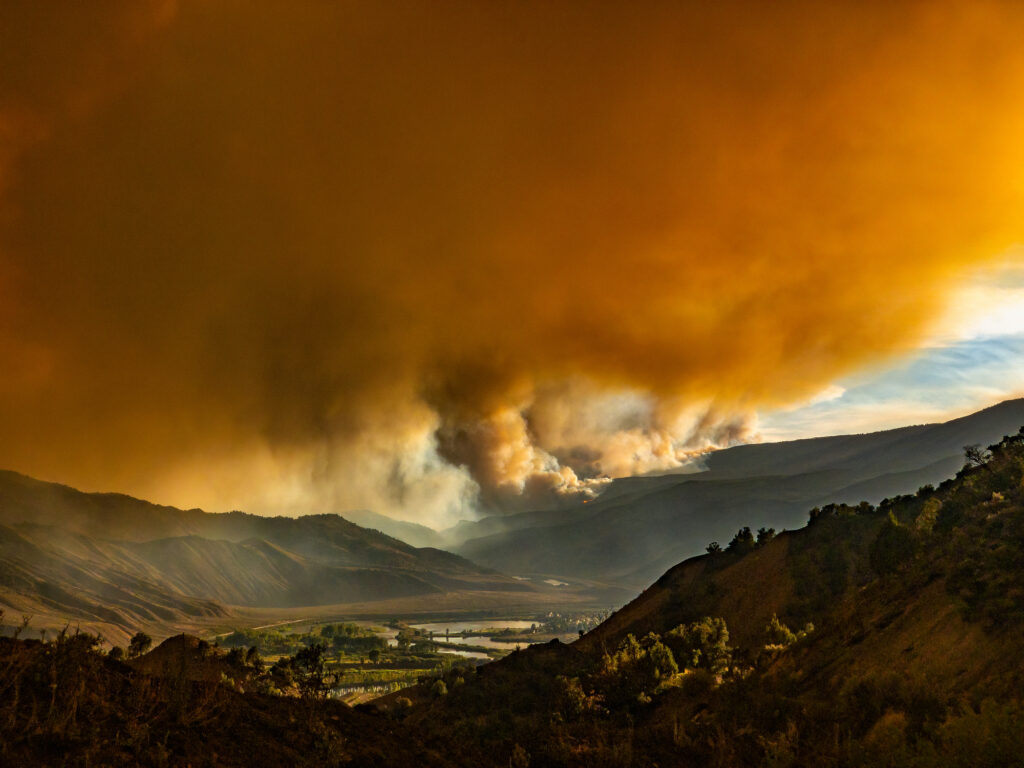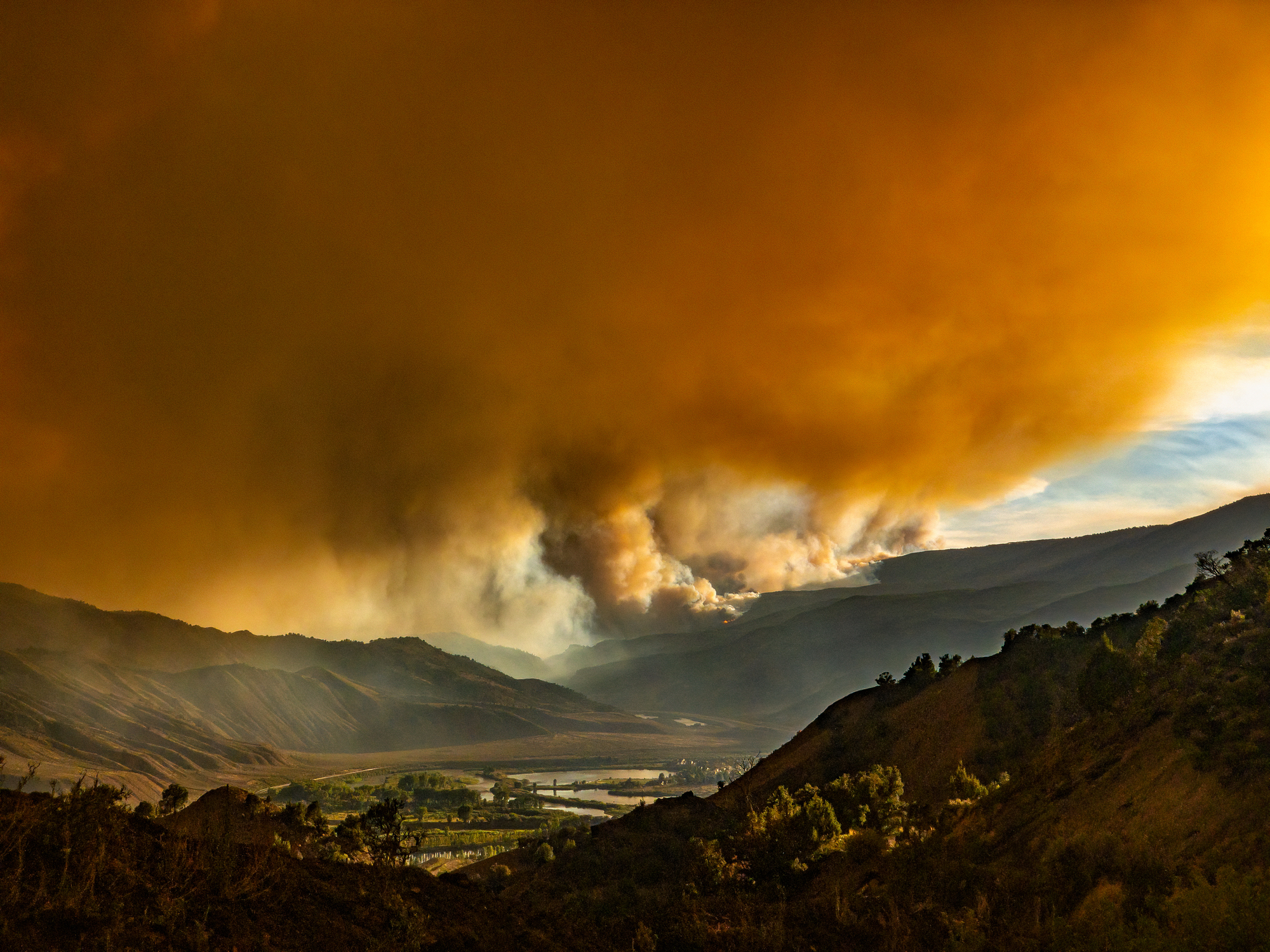Wildfires and the smoke they produce are now unavoidable realities of modern life. In 2020 alone, there were over 58,000 wildfires in the United States, burning a span of over 10 million acres. Places like California, Nevada, and Oregon can be at high risk for wildfires, but if the conditions are hot and dry, a wildfire can ignite virtually anywhere. And it seems wildfires are only becoming bigger, more frequent, and longer-lasting, causing serious air pollution.
There are two reasons this is a serious concern for employers:
1) smoke is a health hazard, and
2) employers are legally required to protect their workers from it.
OSHA Requires You to Reduce Employees’ Exposure to Polluted Air
Wherever you operate, you need to take certain steps to minimize employee exposure to polluted air. The Occupational Safety and Health Administration requires that you have a respiratory protection program in place, and many states go beyond federal regulations.
In California, for instance, the Division of Occupational Safety and Health (Cal/OSHA) requires employers to provide employees with N95 respirators when levels of smoke or other forms of air pollution reach a certain threshold. This necessitates various additional environment, health, and safety procedures such as workplace exposure assessments, medical evaluations, and respirator fit testing.
Make Air Quality a Safety Priority
Air pollution, which can be attributed to a range of pollutants, is measured in terms of particulate matter, which are solid and liquid particles suspended in the air. The smallest and usually most harmful particulate matter is known as PM2.5, which accounts for particles having an aerodynamic diameter of 2.5 micrometers or smaller.
Wildfire smoke health standards are specialized for the air quality index (AQI) for PM2.5. And there are many government agencies that monitor air quality across the many high-risk regions for wildfire smoke.
One essential resource for learning how the air quality is generally in your specific area is AirNow, where you can enter your zip code for up-to-date and forecasted air quality information. Through this U.S. Environmental Protection Agency (EPA) tool you can also learn about current and historical air quality data within cities and towns located in a state’s specific regions. This can be helpful for identifying if you’re operating in an area at high risk for wildfires so you can plan ahead to minimize the workforce’s exposure to harmful smoke in the event of a fire.

The AQI runs from 0 to 500, and according to AirNow, anything over 100 is cause for concern. Depending on just how high the AQI goes dictates what an employer needs to do to meet compliance obligations to protect the workforce. An AQI of 101 to 150 may have adverse health effects on sensitive groups of people. If the AQI gets to 151 or above, that is when the air is deemed unhealthy with a more widespread impact on the general public.
At the state level, specific wildfire smoke-related regulations may apply to workplaces and operations when the current Air Quality Index (AQI) for PM2.5 particulate reaches such an unhealthy level. For example, in California, its emergency regulation section 5141.1, Protection from Wildfire Smoke, largely applies when PM2.5 particulate reaches 151 or greater and where the employer should reasonably anticipate that employees may be exposed to wildfire smoke. This regulation also requires employers to determine employee exposure to PM2.5 for worksites covered under the section before each shift and periodically thereafter as needed.
In addition to using the EPA’s AirNow tool to determine AQI forecasts and current AQI for PM2.5, you can also refer to the U.S. Forest Service’s Interagency Wildland Fire Air Quality Response Program, as well as the websites of applicable state air resource boards (SARBs) and local air pollution control and air quality management districts. The districts, SARBs, and EPA also can provide AQI forecasts and the current AQI for PM2.5 directly if you call, email, text, or otherwise communicate with them.
Conduct Your Own AQI Direct Reads for Peace of Mind
In addition to relying on governmental resources to confirm the current AQI, another option is to use a direct reading instrument. Such measurements may be subject to requirements outlined in applicable state wildfire smoke protection regulations, so be sure to check those out before you start measuring the AQI.
In using the Cal/OSHA regulations as an example, generally, if employees are working outside for more than 1 hour, supervisors should measure current PM2.5 levels to determine their exposure to PM2.5 before and periodically after each shift.
When reading an AQI for PM2.5, be ready to act if levels rise to the 101 to 150 range due to wildfire smoke in an outdoor worksite area. Don’t wait until the AQI for PM2.5 reaches 151 or greater to prepare plans for how to mitigate wildfire smoke exposure.
That’s because once the current AQI for PM2.5 gets to that 151-plus threshold, supervisors should be ready to:
- Provide wildfire smoke awareness training to all affected employees.
- Alert employees that the AQI has reached an unhealthy level and instruct them on specific protective measures to take.
- Encourage employees to check-in when the air quality is getting worse, or if they are suffering from any symptoms due to air quality.
Be aware, too, that state-based regulations may place additional compliance requirements on employers. For instance, in California, when the AQI is 151 or above, employers must implement a system for communicating wildfire smoke hazards in a form readily understandable by all affected employees, including provisions designed to encourage employees to inform the employer of wildfire smoke hazards without fear of reprisal, and train employees according to section 51421.1’s specific requirements. Section 51421.1 also requires them to implement engineering controls and/or changes to work schedules or procedures when possible to reduce employee exposure to PM2.5 to less than a current AQI of 151 (or as low as feasible if less than a current AQI of 151 cannot be achieved).
The key point to remember here is that workplace requirements depend on the current level of air pollution, so if you are able to do a direct read, that can help give you peace of mind that your response is appropriate given the current AQI.
How to Protect Workers When Outside Air Is Harmful
If the AQI indicates that the outside air is harmful, it’s time to act. If employees can’t distance themselves from wildfire smoke or aren’t able to be in an enclosed area with a lower AQI, take precautions and provide them with personal protective equipment (PPE) in the form of respirators.
To protect against wildfire smoke, make sure the respirators you provide to your workforce:
- have an N95 rating
- are approved for use by the National Institute for Occupational Safety and Health (NIOSH)
If you see employees using surgical masks or using homemade masks or scarves, act immediately to get them the PPE they need to meet NIOSH requirements.
Keep in mind, too, that when respirators will be required depends on how high the PM2.5 level gets and for how long the employees have been exposed. For instance:
- When the AQI for PM2.5 reaches a level of 151 or greater, respirators are required for employees’ voluntary use if they will be exposed for longer than an hour.
- If the AQI reaches a level of 500, respirators are mandatory.
When providing respirators, be sure to provide them with an assigned protection factor, so that the PM2.5 levels inside the respirator corresponds to an AQI less than 151.
And prior to assigning respirators, evaluate whether fit testing or medical evaluations are necessary. When the current AQI for PM2.5 is equal to or greater than 151 but does not exceed 500 and respirators are provided for employees’ voluntary use, a fit test is not required. But, if the AQI reaches a level where respirators are mandatory, make sure employees have been properly fit tested to guarantee a proper seal.
Here a few other practical things to keep in mind:
- You may need to relocate employees to an area where the current AQI is lower than PM2.5. You also may need to adjust work schedules, reduce work intensity, or provide additional rest periods.
- To avoid health hazards, be sure to clean, store, and maintain respirators and replace them if they are damaged.
- Train the workforce on proper respirator use and care.
- You may want to suggest disposable filtering facepiece respirators (dust masks) or other half- or full-piece respirators and encourage their safe use to address general concerns over air quality that don’t reach a level requiring N95 respirators.
What to Do During and After a Wildfire
If staying indoors is advised, ensure that the indoor work environment is adequately prepared to handle the potential dangers of wildfire smoke by minimizing exposure to PM2.5 to less than a current AQI of 151 with specific engineering controls.
For starters:
- Instruct employees to keep all windows and doors properly shut inside enclosed buildings and structures and be sure to run the air conditioner or utilize recirculated clean air.
- Keep the fresh-air intake on air conditioning units closed while they run and the filters clean to prevent any outdoor smoke from getting inside.
- Make sure the air is being filtered if employees are using vehicles.
And once a wildfire is extinguished, don’t put those respirators away just yet. Ash gets deposited on the ground for many days following a wildfire, and it’s important to make sure no one is breathing in any dust or ash. The smoke also stays in the air for several days, so once the fire is contained, continue to check the AQI. Also, remind employees to wear safety goggles if necessary, along with long-sleeve shirts and long pants, and gloves as needed and to wash up immediately if any ash gets on their skin.
If an employee has been exposed to smoke inhalation during or following a wildfire, encourage them to seek medical attention, and never reprimand someone who does.
Also, as a best practice encourage employees to report any wildfire smoke hazards at your worksite. Also, remind supervisors and managers that retaliation against an employee for making such reports is unlawful and will not be tolerated.
Training supervisors and your employees with instructions on general safety protocols can help mitigate harmful exposure to PM2.5 if wildfire smoke or other air pollutants impacts the worksite.
We Can Help You Navigate Wildfire Smoke Protection Requirements
If you need help rolling out this type of employee and supervisory training or have general questions about what to do if engineering controls cannot reduce the exposure to PM2.5 to less than a current AQI of 151, KPA can help.

